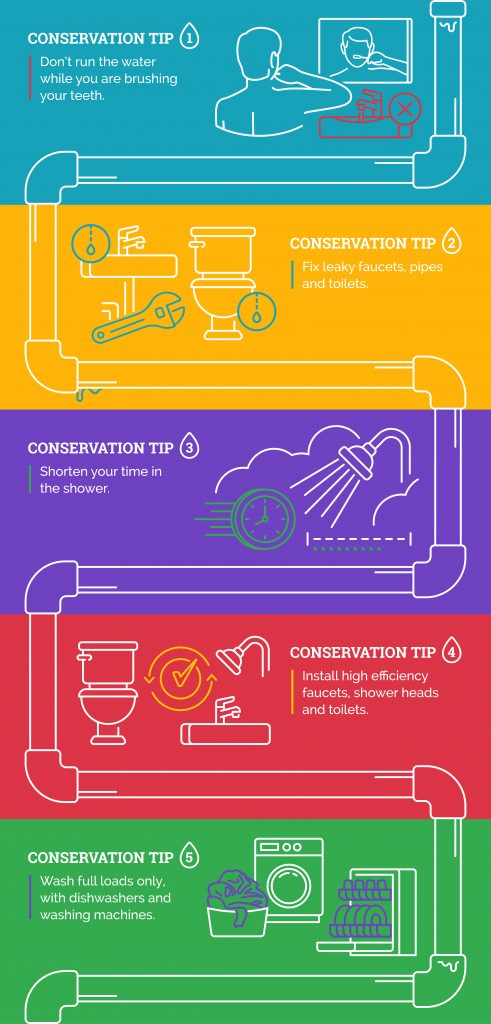
What You Can Do to Save Water Inside the Home
Water is a limited resource so it is vital that we all work together to maintain it and use it wisely.
Here are a few tips you can follow to help conserve:
- Check for leaky toilets (put a drop of food coloring in the tank, let it sit if the water in the bowl turns color, you have a leak).
- Consider replacing your 5 gallon per flush toilet with an efficient 1.6 gallon per flush unit. This will permanently cut your water consumption by 25%.
- Fix leaking fixtures as soon as possible. A leaking faucet or toilet can dribble away thousands of gallons of water a year.
- Run only full loads in dishwashers and washing machines. Rinse all hand-washed dishes at once.
- Turn off the faucet while brushing teeth, or shaving.
- Store a jug of ice water in the refrigerator for a cold drink.
What Can You Do To Save Water Outside the Home?
- Water your lawn and plants in the early morning or evening hours to avoid excess evaporation
- Don’t water on a windy, rainy or very hot day. Wind can scatter water, making your sprinkling less effective. It’s pointless to water when it’s raining. When it’s very hot, water can quickly evaporate before reaching roots.
- Water shrubs and gardens using a slow trickle around the roots. A slow soaking encourages deep root growth, reduces leaf burn or mildew and prevents water loss.
- Apply mulch around flowers, shrubs, vegetables and trees to reduce evaporation, promote plant growth and control weeds.
- Be sure that your hose has a shut-off nozzle. Hoses without a nozzle can spout 10 gallons more per minute.
- To reduce plant watering, select xeriscape (low-water demanding) plants or native plants, which provide an attractive landscape without high water use.
- When washing your car, wet it quickly, turn on the spray, then wash it with soapy water from the bucket. Rinse quickly.
- Be sure sprinklers water only your lawn, not the pavement.
- Plant less grass. Shrubs and ground covers could require less maintenance, less water and provide year-round greenery.
- Never use the hose to clean debris off your driveway or sidewalk. Use a broom.
- Rinse other items, such as bicycles or trash, on the lawn to give your grass an extra drink.
Other Water Tips
- Run the cold tap for approximately two minutes before using for drinking and cooking when the water has not been used for several hours
- Clean your faucet strainers, routinely remove the aerator and clean out debris/sediment
- Use only cold water for cooking and drinking. Hot water can contain sediment solids that build up in the hot water heater over time
- If you use a home water filter replace it routinely. Home water filters, designed to improve taste and remove metals, must be replaced every 6 months or as instructed by the manufacturer. Filters that are not replaced can contain elevated bacteria levels and accumulated metals.
- Drain your hot water heater annually, t his removes unnecessary sediment and calcium particles that can accumulate over time, it also prevents low water pressure and clogging of hot water pipes. Refer to service manual and use caution, the water will be hot and can cause burns.
- After replacing plumbing fixtures or pipes, run the cold water taps (called “flushing”) for several minutes before each use for several days.
- In an emergency such as a broken water pipe, turning the water off where the service line enters the building can prevent damage to your property and save you money. You can usualloy find the water shut-off valve where the water line enters the building. It is a good idea to mark the valve with a bright ribbon or colorful paint so you can find it quickly. It’s also a good idea to make sure the valve works. Turn the valve off, then check several faucets to see if the water is completely off. A plumber can repair or replace a non-working valve
ADDITIONAL CONSERVATION INFORMATION
CT DPH Water Conservation Page
CT EPA Watersense Conservation Page